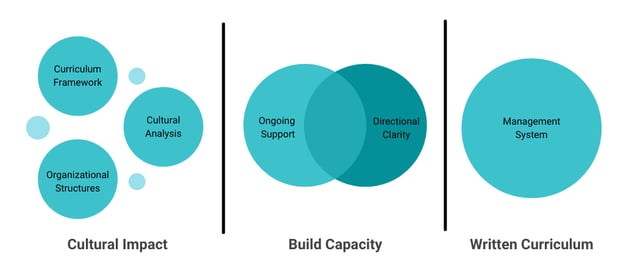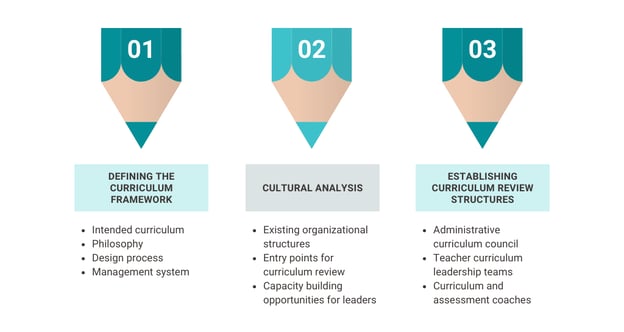When a colleague recently asked me to participate in an interview on leadership philosophy, I didn’t hesitate to say YES! After all, twenty-five years in public education have brought me a great number of experiences shaping my philosophy. Why not give back, as the adage goes? He sent me the list of questions, and I began to prepare.
As I reflected on my journey, it struck me how much my view of leadership style remained constant despite changes in the varying roles. The concept of style, as explained by Hoy and Miskel (2013), encompasses personality, motivation, theoretical values, and problem-solving skills that help leaders balance task accomplishment with interpersonal relationships.
For me, working on this balance has always happened during the facilitation of a meeting and/or projects. It is what Patterson et al (2002) refer to as the “shared pool of meaning.” By its intent, the shared pool builds both team chemistry and product, and ultimately the leader must initiate and sustain changes that originate from both of these outcomes.
When I first arrived at South Western as the Director of Curriculum, Instruction, and Assessment, I quickly realized how little chemistry and product accompanied any curriculum design work. There seemed to be tensions among the people in the system regarding curriculum, mostly because they didn’t seem to understand how both task contribution and team chemistry made up a core value to the design process.
Culturally, the curricular management system of the district was a place where static documents of the intended curriculum reflected compliance to a template with little thought to the design process itself. Teams of teachers would work on a product, and so long as they followed the prescribed set of rules, they were satisfied that the “job” of the curriculum was done. There wasn’t a natural marrying of the design work and the instructional practices of its implementation.
This cultural realization became my work task challenge. How could I lead and support a design framework that would generate a quality written product while building team chemistry, and simultaneously influence the professional capacity that might transform day-to-day instruction and student learning opportunities? I desired to build a system that would impact culture, build instructional capacity, and create a robust written curriculum (see Figure 1).

Figure 1: Curriculum Management Development Process
To construct the cultural and capacity supports for the robust curriculum management system, I focused first on culture, and considered:
- The definition for a district-wide curricular framework.
- The beliefs surrounding the cultural network toward curriculum design and implementation.
- The organizational structures for both product and process.
Curricular Framework
The curricular framework that we began to formally create included a terminology distinction between Intended Curriculum and Learned Curriculum. These concepts were represented by documents and visuals that ultimately defined our design process and how to implement the curriculum once created.
Having the distinction in terms led to helping us shape a broader understanding of the district’s curriculum design philosophy. This philosophy included a written explanation of what we valued in design, and how the entire system’s process was a support to that design.
Having philosophy helped us articulate an exact curriculum design process. This included the development of procedures to follow when building a curriculum map, how to shape professional learning capacity around specific design behaviors during our curriculum phases, and how to rotate people through various stages of the design work to maximize budget, learning focus, and overall feedback processes connected to the quality of the written product.

Figure 2: Process for organizational integration of a curriculum management system
Once we had established a process, we needed to then determine how an online curriculum management system would provide the dynamic and cyclic feedback and development loops essential to the process for design, that fit our overall philosophy, and would help emphasize learned curriculum from intended. All four of these components working together built our entire curricular framework.
Cultural Analysis
Once the curriculum framework had been established, we began to analyze the cultural network of the district. Culture is complex, and so to build a curriculum management system that would be effective within my own district’s culture, I needed to understand existing organizational structures, identify existing entry points for curriculum design and review, and build capacity among a team of designated curriculum leaders.
To evaluate structure, entry points, and capacity-building opportunities, I spent a great amount of time in observation, conversation and reading. Each of these choices on my part allowed me to learn from existing leaders where entry points might be to help implement the framework of a curriculum process that would be understood and effectively followed.
Quickly, I realized how a structure of ongoing review and capacity training for various leaders was a missing element to our entire design process. We did not have a concrete and prioritized structure that allowed for that ongoing review of both curriculum product and the design process. There was only marginal investment given to the review of existing curriculum maps, and people throughout the organization seemed disconnected when viewing instructional practice from the intended written curriculum.
To help move us forward, I formally established three teams - an administrative curriculum council, a teacher curriculum leadership team, and a secondary team of curriculum and assessment liaisons/coaches. Each of these three groups has varying roles and functions, and all meet regularly with me as a facilitator.
Our focus is on building each member’s curriculum leadership capacity, reviewing UbD quality standards to provide feedback on the current maps, and spending time regularly reviewing the effectiveness of instruction by developing and implementing instructional coaching and walk through tools related to observable evidence of curriculum seen in classrooms throughout the district.
In hindsight, this cultural impact process has been all-consuming work – even though moving toward professional capacity and written curriculum product has been a tangible by-product. For instance, designing a philosophy that differentiates the learned and intended curriculum is not straightforward. The learned curriculum often differs from what we intend.
The four components - the written, taught, tested and supported (Glatthorn et al, 2019), require a great deal of precision to definition, constant attention to the details, and persistence to clarify both team understanding and product quality.
I found that having answers to specific questions reinforced how our entire system’s philosophy, design process, and online access were pointing to that intended curriculum structure.
These questions include:
- What would our written curriculum consist of?
- What assessments would inform how we test that written piece?
- How would our resources and technology support implementation?
- What would a taught experience look like through the lens of learning?
Equally complex were the support structures of cultural change. In our system, a laissez-faire attitude had developed over the years of “doing curriculum work.” Curriculum work wasn’t embraced as ongoing. Having this cultural understanding allowed me to consider how I might build shared ownership in leading curricular design as an important part of our system.
I sought entry points and found them in established curriculum development cycles, and in existing leadership roles among teachers and administrators. Still, these entry points viewed “curriculum” tasks as managerial functions – not instructional.
Moving Forward
Knowing that our goal (see Figure 1) for a curriculum management system builds from cultural analysis and capacity around a clearly defined framework, I have fully accepted that not all pieces of our system are smooth. Cultural transformation around curriculum management is a slow process. However, now that we have defined the development process, I am encouraged by what I see.
The greatest actions came in:
- Focusing on the culture to have all stakeholders take a greater interest in the curriculum design process. This happened through the definitions of our curriculum framework.
- Building capacity through tiered leadership teams focused on curriculum review and ongoing support and training.
- Structuring curriculum leadership opportunities through coaching and observation to emphasize and validate the connections between written curriculum products with the taught, tested, and supported implementation.
The online curriculum management system we selected was Eduplanet21’s Unit Planner, coupled with their PLUS Professional Learning Institutes. Our partnership with Eduplanet21 has included consortium work with other local districts, customization of professional learning pathways, and ongoing support of our curriculum management system through professional customer service.
Learn how Eduplanet21 can help your school or district.
About the Author
Robert S. Freil, Ed.D | Director of Curriculum Instruction and Assessment
South Western School District, Hanover PA 17331
rob_freil@southwesternsd.org | Twitter: @rfreil
References
Deal, T.E. & Deal, K.D. (2009). Shaping school culture: pitfalls, paradoxes and promises. San Francisco: Joney Bass.
Glatthorn, A.A. et al (2019). Curriculum leadership, 5th edition. Thousand Oaks: Sage.
Hoy, W.K. & Miskel, C.G. (2012). Educational administration: theory, research and practice, 9th edition. New York: McGraw Hill.
Paterson, K., Granny, J., McMillan, R & Switzler, A. (2002). Crucial conversations: tools for talking when stakes are high. New York: McGraw Hill.
 Login
Login

